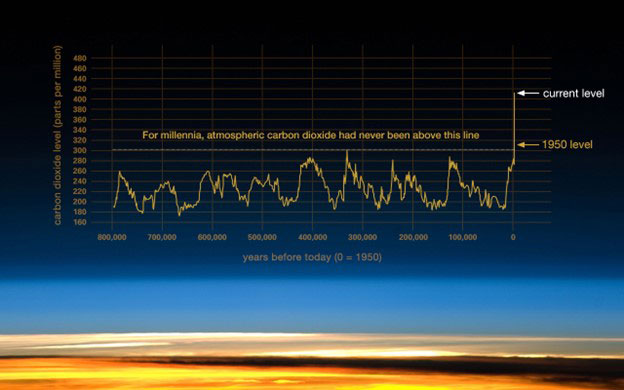Earth, our home, is over 4.5 billion years old. Through its turbulent geologic history, life has found a way to survive despite epic changes in climate. Warmer and colder climates would come and go. However, some of the changes occurred so rapidly, they caused the extinction of many forms of life. For example, during the Permian period, some 252 million years ago, nearly all life in the sea was lost due to a global warming event that occurred due to the rapid change of gases that surround Earth’s atmosphere due to volcanic activity. The change of the composition of Earth’s air led to a spiraling increase in the ambient temperature, as well as acid rain that changed the chemistry of the oceans. As what occurs still today, the ocean absorbed the accumulating carbon dioxide, acid rain and excess heat, which in turn, increased the pH of the ocean and reduced the available dissolved oxygen, which made life possible. As dissolved oxygen concentrations reduced and the pH changed, year by year, life began to dwindle. Over a 200,000-year time period, 96% of all life in the sea became extinct. It took nearly five million years for the sea to return to a state of life that we would recognize today. Through this example, we see how fragile life is, and the devastating effects that will occur again if our oceans become too warm and too acidic.
All of humanity has benefited from the advancement of human civilization. The industrial revolution has given rise to a global society that never existed before in such a grand scale. The expansion of our civilizations has spread to nearly every location on the planet, and through modern technology, has given humans an advantage over their predecessors that allowed them to succeed in the most remote of places. Humanity has thrived. The production of food in massive quantities through the use of fertilizers has strengthen our communities around the globe, allowing humans the ability to populate the Earth as never before in our history. Transportation has become accessible and affordable for all. The invention of trains/railroads, automobiles/roads and airplanes have given us the ability to commute great distances. If we have enough money, we can get to any location on the planet in a very short period of time. These are just a few of the magnificent benefits of modern civilization. However, they come at a cost to both our health and our environment, as we have noticed over the last century. Choking smog in our cities, polluted waterways and pesticides in our food abound. However, the majority of consequences to our environment have gone unnoticed for the most part, as they are “out of sight, out of mind” for most people. For the first time in recorded history, humans themselves are starting to affect the natural cycle of our planet’s atmospheric conditions, resulting in what is being called “Climate Change” or “Global Warming”. The science is irrefutable and has been confirmed by scientists all around the planet. We are changing the atmosphere artificially, resulting in a rise of carbon dioxide, methane, nitrous oxide and other greenhouse gases. Naturally, in times of volcanic activity, as occurred in the Permian period, the levels of these greenhouse gases would rise slowly over thousands of years. We are currently in a period of low volcanic activity, yet our greenhouse gases are rising at levels many times faster than what occurs naturally, as is demonstrated in this graph from NOAA. In the last million years, our CO2 level has never risen about 400ppm, despite several highly volcanic periods of time. Yet, in 2013, at the Mauna Loa Mountaintop Observatory, we rose above 400ppm for the first time in recorded human history. By 2015, several observations recorded measurements of 400ppm or higher. By 2016, the lowest of recordings never dropped below 400. With the increase of CO2, we have seen the warmest temperatures our planet has seen for an era, and a change to our climactic weather patterns.
Credit: NASA (https://climate.nasa.gov/climate_resources/24/graphic-the-relentless-rise-of-carbon-dioxide/)
As our population grows, the need for energy, food and transportation grows simultaneously. This results in an even greater demand for fossil fuels, and therefore, more pollution. We are already starting to see the effects of climate change on our oceans. Year after year, we are seeing new records being set in both global air and sea temperatures. Polar sea ice is melting at record levels and not being replaced at the same rate in the winter seasons. Tundra that has been frozen for thousands of years are thawing, releasing great amounts of stored carbon dioxide into the atmosphere. The rising sea temperatures are stimulating the growth of massive algal blooms, including Blue-Green algae and Red Tide, which, in turn, results in massive reductions of dissolved oxygen and stratification of layers in our oceans. This, in combination with the brevetoxin released by the Red Tide organism, a toxin that paralyzes all breathing life forms, results in the catastrophic die-offs which kill all life in the surrounding areas, fish, turtles, corals, crabs, invertebrates, manatees, sharks and whales equally. The effects are devastating to not only the wildlife in the area, but to humans as well. An economic ripple effect occurs when Beaches are closed and therefore tourism takes a major decline. The economy and livelihood of many people in the tourism and restaurant businesses suffer. Commercial fishermen must travel greater distances from their port to find the same level of catch they previously found prior to the algal blooms and stratification. The amount of economic loss to the businesses in the area is enormous, and has lasting effects on the community.
Imagine this scenario; we ignore the warnings that have been given to us by thousands of scientists all around the globe who have been warning of the dire consequences of our dependence upon fossil fuels and the catastrophic results of inaction. What would life be like if we cause a massive extinction event, that cannot be stopped once it starts to occur, due to increased temperatures and acidity? What would happen if billions of animals start to die unexpectedly due to this increase, as occurs in red tide events? What could we do to stop it? Therefore, we must ACT NOW. We must be proactive and work with universities, government agencies and non-profit organizations, all who are working to conserve our aquatic ecosystems around the planet. Many of these organizations do not have the personnel or expertise underwater to conduct the surveys that are required to finish the research they are conducting. Therefore, our mission at Reef Expeditions is to provide an avenue for these organizations, by creating an “Army” of citizen scientists to help in their endeavors. By training scuba divers who have the time, passion, and ability to learn the required scientific knowledge and underwater methodologies for underwater research, we can help these scientists complete their research studies that provide information to the state of our environment and provide potential solutions to our current environmental crisis. Please consider supporting our cause either financially or by becoming a volunteer with our organization. Your actions now could be the change needed to save coral reefs around the world for generations to come.

